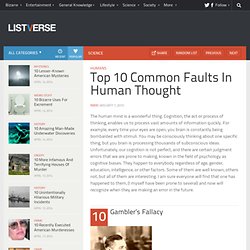

35 Ultimate Psychology Facts - PsychTronics. 35 Ultimate Psychology Facts Amazing Psychology facts which you don’t even find in google search.

These are psychology facts which are taken from the most experienced and top level psychologists. 1.When it comes to placebo, studies have found that a capsule works better than a tablet, and a syringe works better than a capsule (in terms of how successful the placebo effect is). 2. A placebo effect can work even when the individual is aware that the substance they are taking is a placebo. List of cognitive biases. Systematic patterns of deviation from norm or rationality in judgment Cognitive biases are systematic patterns of deviation from norm and/or rationality in judgment. They are often studied in psychology, sociology and behavioral economics.[1] Although the reality of most of these biases is confirmed by reproducible research,[2][3] there are often controversies about how to classify these biases or how to explain them.[4] Several theoretical causes are known for some cognitive biases, which provides a classification of biases by their common generative mechanism (such as noisy information-processing[5]).
Gerd Gigerenzer has criticized the framing of cognitive biases as errors in judgment, and favors interpreting them as arising from rational deviations from logical thought.[6] Explanations include information-processing rules (i.e., mental shortcuts), called heuristics, that the brain uses to produce decisions or judgments. Belief, decision-making and behavioral[edit] Social[edit] [edit] Cognitive Dissonance. Explanations > Theories > Cognitive Dissonance Description | Research | Example | So What?

| See also | References Description This is the feeling of uncomfortable tension which comes from holding two conflicting thoughts in the mind at the same time. Dissonance increases with: The importance of the subject to us. Dissonance is often strong when we believe something about ourselves and then do something against that belief. Cognitive dissonance is a very powerful motivator which will often lead us to change one or other of the conflicting belief or action. Change our behavior. Dissonance is most powerful when it is about our self-image. If an action has been completed and cannot be undone, then the after-the-fact dissonance compels us to change our beliefs. Cognitive dissonance appears in virtually all evaluations and decisions and is the central mechanism by which we experience new differences in the world. Note: Self-Perception Theory gives an alternative view.
Research Example So what? Top 10 Common Faults In Human Thought. Humans The human mind is a wonderful thing.

Cognition, the act or process of thinking, enables us to process vast amounts of information quickly. For example, every time your eyes are open, you brain is constantly being bombarded with stimuli. You may be consciously thinking about one specific thing, but you brain is processing thousands of subconscious ideas. Unfortunately, our cognition is not perfect, and there are certain judgment errors that we are prone to making, known in the field of psychology as cognitive biases. The Gambler’s fallacy is the tendency to think that future probabilities are altered by past events, when in reality, they are not. The History of Human Thinking (in 6 minutes, 4 seconds) 15 styles of Distorted Thinking. 15 styles of Distorted Thinking Filtering: You take the negative details and magnify them while filtering out all positive aspects of a situation.

Polarized Thinking: Things are black or white, good or bad. You have to be perfect or you're a failure. There is no middle ground. Overgeneralization: You come to a general conclusion based on a single incident or piece of evidence. Checklist for Hidden Anger. 50 Common Cognitive Distortions. 3. Negative predictions. Overestimating the likelihood that an action will have a negative outcome. 4. Underestimating coping ability.
Underestimating your ability cope with negative events. 5. Thinking of unpleasant events as catastrophes. 6. For example, during social interactions, paying attention to someone yawning but not paying the same degree of attention to other cues that suggest they are interested in what you’re saying (such as them leaning in). The Nature of the Self: Experimental Philosopher Joshua Knobe on How We Know Who We Are. By Maria Popova A mind-bending new understanding of our basic existential anchor.

“The fate of the world depends on the Selves of human beings,” pioneering educator Annemarie Roeper wrote in her meditation on how poorly we understand the self. Indeed, while philosophers may argue that the self is a toxic illusion and psychologists may insist that it’s forever changing, we tend to float through life anchored by a firm conviction that the self is our sole constant companion. But when psychologist David DeSteno asks “Can the present you trust the future you?” In his fantastic exploration of the psychology of trust, the question leaves us — at least, leaves me — suddenly paralyzed with the realization that the future self is in many ways fundamentally different from the present self.
Though the full talk is remarkable in its entirety and is well worth the watch, here is what I find to be Knobe’s most poignant pause-giver: Donating = Loving Brain Pickings has a free weekly newsletter. The Self Illusion: How Our Social Brain Constructs Who We Are.